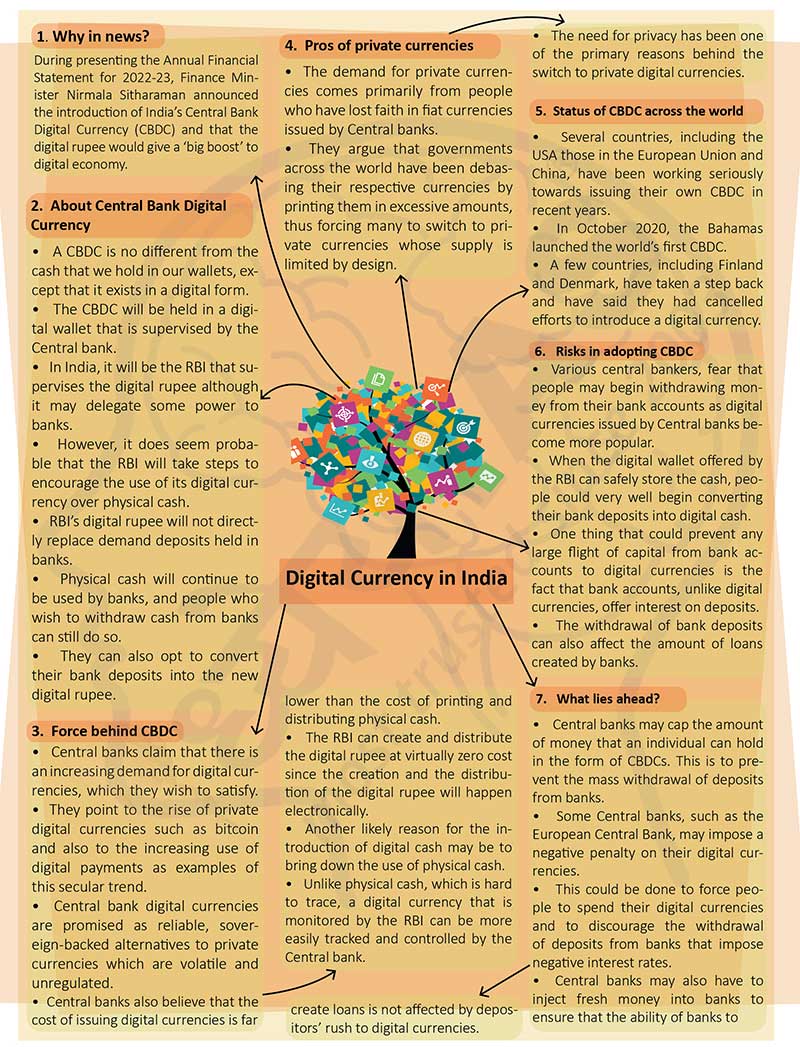Brain-booster /
03 Mar 2022
Brain Booster for UPSC & State PCS Examination (Topic: Digital Currency in India)

Why in news?
- During presenting the Annual Financial Statement for 2022-23, Finance
Minister Nirmala Sitharaman announced the introduction of India’s Central
Bank Digital Currency (CBDC) and that the digital rupee would give a ‘big
boost’ to digital economy.
About Central Bank Digital Currency
- A CBDC is no different from the cash that we hold in our wallets, except
that it exists in a digital form.
- The CBDC will be held in a digital wallet that is supervised by the
Central bank.
- In India, it will be the RBI that supervises the digital rupee although
it may delegate some power to banks.
- However, it does seem probable that the RBI will take steps to encourage
the use of its digital currency over physical cash.
- RBI’s digital rupee will not directly replace demand deposits held in
banks.
- Physical cash will continue to be used by banks, and people who wish to
withdraw cash from banks can still do so.
- They can also opt to convert their bank deposits into the new digital
rupee.
Force behind CBDC
- Central banks claim that there is an increasing demand for digital
currencies, which they wish to satisfy.
- They point to the rise of private digital currencies such as bitcoin and
also to the increasing use of digital payments as examples of this secular
trend.
- Central bank digital currencies are promised as reliable, sovereign-
backed alternatives to private currencies which are volatile and
unregulated.
- Central banks also believe that the cost of issuing digital currencies
is far lower than the cost of printing and distributing physical cash.
- The RBI can create and distribute the digital rupee at virtually zero
cost since the creation and the distribution of the digital rupee will
happen electronically.
- Another likely reason for the introduction of digital cash may be to
bring down the use of physical cash.
- Unlike physical cash, which is hard to trace, a digital currency that is
monitored by the RBI can be more easily tracked and controlled by the
Central bank.
Pros of private currencies
- The demand for private currencies comes primarily from people who have
lost faith in fiat currencies issued by Central banks.
- They argue that governments across the world have been debasing their
respective currencies by printing them in excessive amounts, thus forcing
many to switch to private currencies whose supply is limited by design.
- The need for privacy has been one of the primary reasons behind the
switch to private digital currencies.
Status of CBDC across the world
- Several countries, including the USA those in the European Union and
China, have been working seriously towards issuing their own CBDC in recent
years.
- In October 2020, the Bahamas launched the world’s first CBDC.
- A few countries, including Finland and Denmark, have taken a step back
and have said they had cancelled efforts to introduce a digital currency.
Risks in adopting CBDC
- Various central bankers, fear that people may begin withdrawing money
from their bank accounts as digital currencies issued by Central banks
become more popular.
- When the digital wallet offered by the RBI can safely store the cash,
people could very well begin converting their bank deposits into digital
cash.
- One thing that could prevent any large flight of capital from bank
accounts to digital currencies is the fact that bank accounts, unlike
digital currencies, offer interest on deposits.
- The withdrawal of bank deposits can also affect the amount of loans
created by banks.
What lies ahead?
- Central banks may cap the amount of money that an individual can hold in
the form of CBDCs. This is to prevent the mass withdrawal of deposits from
banks.
- Some Central banks, such as the European Central Bank, may impose a
negative penalty on their digital currencies.
- This could be done to force people to spend their digital currencies and
to discourage the withdrawal of deposits from banks that impose negative
interest rates.
- Central banks may also have to inject fresh money into banks to ensure
that the ability of banks to create loans is not affected by depositors’
rush to digital currencies.









